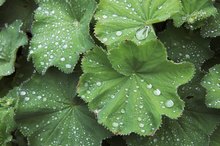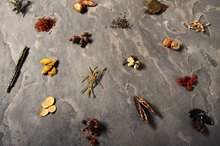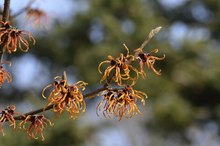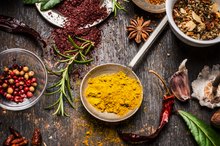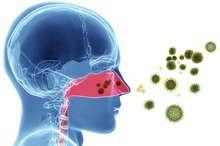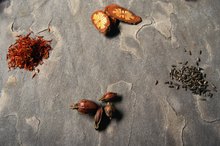Herbal Treatment for Internal Bleeding
Internal bleeding has a range of causes, including injury, ulcers, irritable bowel syndrome, Crohn’s disease, urinary tract infections, hormonal imbalance and uterine fibroids. Herbs can treat the underlying disease and, in some cases, stop the bleeding naturally. You should consult your health care provider for a diagnosis of the cause before starting herbal treatment.
If you are experiencing serious medical symptoms, seek emergency treatment immediately.
Herbal Actions
Herbs that may cure internal bleeding act in several ways. Anti-hemorrhagic or styptic herbs can prevent and stop excessive internal bleeding in some cases. Some herbs affect female reproductive organs and regulate excessive bleeding from fibroids and menstruation. Herbs that heal an irritated gastrointestinal tract may also stop bleeding from certain diseases. Check with a qualified practitioner for advice about dosage and preparation of herbs to cure internal bleeding.
- Herbs that may cure internal bleeding act in several ways.
- Anti-hemorrhagic or styptic herbs can prevent and stop excessive internal bleeding in some cases.
Wild Geranium
Herbs That Stop Heavy Bleeding With Fibroids
Learn More
Wild geranium, Geranium maculatum, is a woodland herb with pink flowers. Herbalists use the roots to stop bleeding and treat diarrhea, hemorrhoids, gum diseases and gastrointestinal problems. Wild geranium is rich in tannins and is highly astringent and styptic. In their 2001 book, “Herbal Remedies,” naturopathic doctors Asa Hershoff and Andrea Rotelli recommend it for bleeding in the digestive tract due to ulcers, Crohn’s disease or diarrhea and for excess vaginal bleeding 1. Do not use this herb if you are constipated or pregnant.
- Wild geranium, Geranium maculatum, is a woodland herb with pink flowers.
- In their 2001 book, “Herbal Remedies,” naturopathic doctors Asa Hershoff and Andrea Rotelli recommend it for bleeding in the digestive tract due to ulcers, Crohn’s disease or diarrhea and for excess vaginal bleeding 1.
Birthroot
Birthroot, Trillium erectum, is a North American herb with tiny, dark red flowers. Traditional healers use the roots and rhizomes to treat hemorrhage, excessive menstrual bleeding and bowel problems. The plant is high in tannins and saponins and has anti-inflammatory and anti-hemorrhagic actions. Hershoff and Rotelli state that birthroot is useful for internal bleeding from fibroids, menopausal bleeding and uterine prolapse. Do not use this herb during pregnancy.
- Birthroot, Trillium erectum, is a North American herb with tiny, dark red flowers.
- Traditional healers use the roots and rhizomes to treat hemorrhage, excessive menstrual bleeding and bowel problems.
Yarrow
Are There Herbs That Dissolve Intestinal Mucus?
Learn More
Yarrow, Achillea millefolium, is an ancient European herb noted for staunching wounds. In his 2003 book, “Medical Herbalism: The Science and Practice of Herbal Medicine,” clinical herbalist David Hoffmann, FNIMH, AHG, cites its use for uterine hemorrhage and profuse menstruation 2. The active chemicals include volatile oil, sesquiterpene lactones, tannins and flavonoids, and yarrow has astringent and anti-inflammatory actions. Hershoff and Rotelli also recommend it for internal bleeding from the lungs, bladder, bowels and internal injuries. Do not use yarrow if you have allergies to plants in the Aster family.
- Yarrow, Achillea millefolium, is an ancient European herb noted for staunching wounds.
- In his 2003 book, “Medical Herbalism: The Science and Practice of Herbal Medicine,” clinical herbalist David Hoffmann, FNIMH, AHG, cites its use for uterine hemorrhage and profuse menstruation 2.
Related Articles
References
- “Herbal Remedies”; Asa Hershoff, N.D., and Andrea Rotelli, N.D.; 2001
- “Medical Herbalism: The Science and Practice of Herbal Medicine”; David Hoffmann; 2003
- Raphaeli T, Menon R. Current treatment of lower gastrointestinal hemorrhage. Clin Colon Rectal Surg. 2012;25(4):219–227. doi:10.1055/s-0032-1329393
- Kim BS, Li BT, Engel A, et al. Diagnosis of gastrointestinal bleeding: A practical guide for clinicians. World J Gastrointest Pathophysiol. 2014;5(4):467–478. doi:10.4291/wjgp.v5.i4.467
- Grooteman KV, van Geenen E, Kievit W, Drenth J. Chronic anemia due to gastrointestinal bleeding: when do gastroenterologists transfuse?. United European Gastroenterol J. 2017;5(7):967–973. doi:10.1177/2050640617694278
- Turner J, Parsi M, Badireddy M. Anemia. [Updated 2020 Jan 20]. In: StatPearls [Internet]. Treasure Island (FL): StatPearls Publishing; 2020 Jan-. Available from: https://www.ncbi.nlm.nih.gov/books/NBK499994/
- Freeman AM, Morando DW. Anemia Screening. [Updated 2020 Jan 15]. In: StatPearls [Internet]. Treasure Island (FL): StatPearls Publishing; 2020 Jan-. Available from: https://www.ncbi.nlm.nih.gov/books/NBK499905/
- National Institute of Diabetes and Digestive and Kidney Diseases. Gastrointestinal (GI) Bleeding. Definition & Facts of GI Bleeding. niddk.nih.gov July 2016
- DiGregorio AM, Alvey H. Gastrointestinal Bleeding. [Updated 2019 Apr 10]. In: StatPearls [Internet]. Treasure Island (FL): StatPearls Publishing; 2020 Jan-. Available from: https://www.ncbi.nlm.nih.gov/books/NBK537291/
- Guntipalli P, Chason R, Elliott A, Rockey DC. Upper gastrointestinal bleeding caused by severe esophagitis: a unique clinical syndrome. Dig Dis Sci. 2014;59(12):2997–3003. doi:10.1007/s10620-014-3258-4
- Cremers I, Ribeiro S. Management of variceal and nonvariceal upper gastrointestinal bleeding in patients with cirrhosis. Therap Adv Gastroenterol. 2014;7(5):206–216. doi:10.1177/1756283X14538688
- Rawla P, Devasahayam J. Mallory Weiss Syndrome. [Updated 2019 Nov 24]. In: StatPearls [Internet]. Treasure Island (FL): StatPearls Publishing; 2020 Jan-. Available from: https://www.ncbi.nlm.nih.gov/books/NBK538190/
- Xi B, Jia JJ, Lin BY, Geng L, Zheng SS. Peptic ulcers accompanied with gastrointestinal bleeding, pylorus obstruction and cholangitis secondary to choledochoduodenal fistula: A case report. Oncol Lett. 2016;11(1):481–483. doi:10.3892/ol.2015.3908
- Farmer RG. Lower gastrointestinal bleeding in inflammatory bowel disease. Gastroenterol Jpn. 1991;26 Suppl 3:93–100. doi:10.1007/bf02779274
- Sun Z, Migaly J. Review of Hemorrhoid Disease: Presentation and Management. Clin Colon Rectal Surg. 2016;29(1):22–29. doi:10.1055/s-0035-1568144
- Lynch WD, Hsu R. Ulcerative Colitis. [Updated 2019 Dec 17]. In: StatPearls [Internet]. Treasure Island (FL): StatPearls Publishing; 2020 Jan-. Available from: https://www.ncbi.nlm.nih.gov/books/NBK459282/
- Podugu A, Tandon K, Castro FJ. Crohn's disease presenting as acute gastrointestinal hemorrhage. World J Gastroenterol. 2016;22(16):4073–4078. doi:10.3748/wjg.v22.i16.4073
- Viborg S, Søgaard KK, Farkas DK, Nørrelund H, Pedersen L, Sørensen HT. Lower Gastrointestinal Bleeding And Risk of Gastrointestinal Cancer. Clin Transl Gastroenterol. 2016;7(4):e162. Published 2016 Apr 7. doi:10.1038/ctg.2016.16
- Lanas A, Ferrández A. Treatment and prevention of aspirin-induced gastroduodenal ulcers and gastrointestinal bleeding. Expert Opin Drug Saf. 2002;1(3):245–252. doi:10.1517/14740338.1.3.245
- Narayanan M, Reddy KM, Marsicano E. Peptic Ulcer Disease and Helicobacter pylori infection. Mo Med. 2018;115(3):219–224.
- Sung JJ, Tsoi KK, Lai LH, Wu JC, Lau JY. Endoscopic clipping versus injection and thermo-coagulation in the treatment of non-variceal upper gastrointestinal bleeding: a meta-analysis. Gut. 2007;56(10):1364–1373. doi:10.1136/gut.2007.123976
- Takeuchi N, Emori M, Yoshitani M, Soneda J, Takada M, Nomura Y. Gastrointestinal Bleeding Successfully Treated Using Interventional Radiology. Gastroenterology Res. 2017;10(4):259–267. doi:10.14740/gr851e
- "Ulcers and Gastrointestinal Bleeding: Protecting Your Health." American College of Gastroenterology.
- "Bleeding in the Digestive Tract." NIH Publication No. 07–1133 November 2004. National Digestive Diseases Information Clearinghouse (NDDIC).
Writer Bio
Janet Contursi has been a writer and editor for more than 23 years. She has written for professional journals and newspapers, and has experience editing educational, cultural, and business articles and books. Her clients include Gale Publishers, Anaxos, Vielife and Twin Cities Wellness. Contursi earned her Ph.D. at the University of Minnesota, where she studied cultural anthropology, South Asian languages and culture, and art history.
